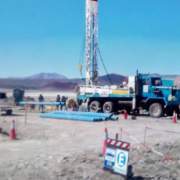Ultra Lithium Identifies Brine Lithium Exploration Targets at the South Big Smoky Valley Brine Lithium Project
Vancouver, BC – Ultra Lithium Inc. (TSX-V: ULI) (FSE: QFB) (“ULI” or “the Company”) is pleased to announce that it has received the Controlled Source Audio-Frequency Magneto-telluric (CSAMT) ground geophysical survey data interpretation report which identifies several very interesting brine lithium exploration targets at its 100% owned South Big Smokey Valley brine lithium project in Nevada, USA.
Highlights of the geophysical survey results are:
- Several targets representing potential lithium bearing brines and structural traps favourable for brine accumulation have been identified in two distinct areas (southwestern area and northeastern area).
- In nearby Clayton Valley, lithium-bearing brines are known to be of very low resistivity and controlled by faulting.
- The goal of the geophysical survey was to delineate the extent and depth of very low resistivities, and to map, if possible, faults that may influence brine accumulation.
- The present survey is based on a previously identified gravity lows identified in a gravity survey carried out by US Geological Survey in 1975 covering the South Big Smokey Valley and adjacent Clayton Valley.
The Company contracted Zonge International of Tucson, Arizona, USA, in 2014 to complete a CSAMT ground geophysical survey work on the Property. The survey consisted of eight CSAMT survey lines (called Lines A through H) covering 53.8 kilometers of data. Recently received survey interpretation report indicates that, in the southwestern area of a historical gravity low, the largest area of lowest resistivities is seen on Line G from stations 5050 to 6700; the adjacent lines A and H are also low resistivity, though not as low as on Line G. A very tentative fault or contact in the vicinity of station 6800 on Line G is possible, suggesting a possible target for deep, low resistivity brines in the vicinity of stations 6000 to 6500. In the area of the northeastern oblong historical gravity low, the lowest resistivities are indicated south of Line E, in the vicinity of station 6200 on Line F and from station 9400 on Line C to station 2800 on Line D. Evidence for faulting is very tentative in this area, and the depth of investigation does not extend as deeply as on the southwestern lines.
CSAMT is a surface-based electromagnetic method that provides subsurface electrical resistivity information, which can often be related to changes in pore space and pore fluids. Bedrock is often high resistivity relative to overlying material, and fractured, saturated bedrock is often lower resistivity than un-fractured bedrock. Areas of high total dissolved solids (TDS) in the groundwater appear more conductive than equivalent areas of low TDS. Variations in depth to bedrock, faulting, and other structural changes are often also evident as changes in resistivity. In nearby Clayton Valley, lithium- bearing brines are known to be of very low resistivity and controlled by faults related to tectonic subsidence. The goal of the CSAMT survey was to delineate the extent and depth of very low resistivities, and to map, if possible, faults that may influence brine accumulation.
Dr. Weiguo Lang, CEO of Ultra, stated that, “We are excited with the ground geophysical survey interpretation results which attest to the merit of the South Big Smokey project as an excellent brine lithium exploration project. The Company is in the process of interpreting data from December 2015 surface sediment sampling results. This sampling program was carried out as a follow up of the ground geophysical survey.”
The technical information contained in this news release has been reviewed and approved by Afzaal Pirzada, P.Geo., a qualified person, as defined by NI 43-101 who works as a consultant with the Company.
About the South Big Smokey Valley Brine Lithium Project
The Company holds a 100% interest in the Big Smoky Valley Project comprising 659 placer claims covering approximately 13,000 acres’ land located in Nevada, USA. This Project has geological conditions favourable for hosting Lithium enriched brines. The Project is located 16 miles to the north of Albemarle Corp.’s Silver Peak mine (previously Chemetall), which is the only brine lithium producing project in North America, and has been producing lithium from brines since 1966. The Company has completed a ground CSAMT geophysical survey and surface sediment / water sampling programs on the project and intends to be drilling in 2016.
About Ultra Lithium Inc.
Ultra Lithium is an exploration and development company with a focus on the acquisition and development of lithium assets. The Company is currently focused on North American acquisitions and exploring its Big Smoky Valley Project located in Nevada, USA. The Big Smoky Valley project is in the vicinity of Abermarle’s Silver Peak mine and only 310 kilometres from Tesla’s upcoming Gigafactory.
On behalf of the Board of Directors
Kiki Smith, CFO
For further information, please contact:
Kiki Smith, CFO
T: +1-778-968-1176
F: +1-604-909-4682
E: kiki@ultralithium.com
W: www.ultralithium.com
Or view the Company’s filings at www.sedar.com
Cautionary Statement Regarding “Forward-Looking” Information
Some of the statements contained in this press release are forward-looking statements and information within the meaning of applicable securities laws. Forward-looking statements and information can be identified by the use of words such as “plans”, “expects”, “intends”, “is expected”, “potential”, “suggests” or variations of such words or phrases, or statements that certain actions, events or results “may”, “could”, “should”, “would”, “might” or “will” be taken, occur or be achieved. Forward-looking statements and information are not historical facts and are subject to a number of risks and uncertainties beyond the Company’s control. Actual results and developments are likely to differ, and may differ materially, from those expressed or implied by the forward-looking statements contained in this news release. Accordingly, readers should not place undue reliance on forward-looking statements. The Company undertakes no obligation to update publicly or otherwise revise any forward-looking statements, except as may be required by law.
Neither TSX Venture Exchange nor its Regulations Services Provider (as that term is defined in policies of the TSX Venture Exchange) accepts responsibility for the adequacy or accuracy of this release.




